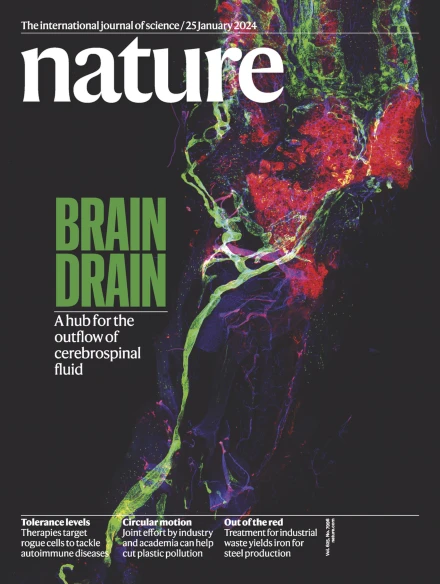Wetland emission and atmospheric sink changes explain methane growth in 2020
IF 50.5
1区 综合性期刊
Q1 MULTIDISCIPLINARY SCIENCES
引用次数: 39
Abstract
Atmospheric methane growth reached an exceptionally high rate of 15.1 ± 0.4 parts per billion per year in 2020 despite a probable decrease in anthropogenic methane emissions during COVID-19 lockdowns1. Here we quantify changes in methane sources and in its atmospheric sink in 2020 compared with 2019. We find that, globally, total anthropogenic emissions decreased by 1.2 ± 0.1 teragrams of methane per year (Tg CH4 yr−1), fire emissions decreased by 6.5 ± 0.1 Tg CH4 yr−1 and wetland emissions increased by 6.0 ± 2.3 Tg CH4 yr−1. Tropospheric OH concentration decreased by 1.6 ± 0.2 per cent relative to 2019, mainly as a result of lower anthropogenic nitrogen oxide (NOx) emissions and associated lower free tropospheric ozone during pandemic lockdowns2. From atmospheric inversions, we also infer that global net emissions increased by 6.9 ± 2.1 Tg CH4 yr−1 in 2020 relative to 2019, and global methane removal from reaction with OH decreased by 7.5 ± 0.8 Tg CH4 yr−1. Therefore, we attribute the methane growth rate anomaly in 2020 relative to 2019 to lower OH sink (53 ± 10 per cent) and higher natural emissions (47 ± 16 per cent), mostly from wetlands. In line with previous findings3,4, our results imply that wetland methane emissions are sensitive to a warmer and wetter climate and could act as a positive feedback mechanism in the future. Our study also suggests that nitrogen oxide emission trends need to be taken into account when implementing the global anthropogenic methane emissions reduction pledge5. Using both bottom-up and top-down approaches, the record high increase in the methane growth rate in 2020 is attributed mainly to emissions from wetlands, which have been exacerbated by a warmer and wetter climate, and to the reduced atmospheric methane sink, in response to emissions reduction of air pollutants during COVID-19 lockdowns.

湿地排放和大气汇变化解释了 2020 年甲烷增长的原因
尽管 COVID-19 锁定期间人为甲烷排放可能会减少,但 2020 年大气中的甲烷增长率达到了每年十亿分之 15.1 ± 0.4 的极高水平1。 在此,我们量化了 2020 年与 2019 年相比甲烷来源及其大气吸收汇的变化。对流层OH浓度相对于2019年下降了1.6±0.2%,这主要是由于人为氮氧化物 (NOx)排放量减少,以及在大流行锁定期间相关的对流层臭氧游离量减少2。根据大气反演, 我们还推断,2020 年全球甲烷净排放量比 2019 年增加了 6.9 ± 2.1 Tg CH4 yr-1,而全球甲烷与 OH 反应的去除量减少了 7.5 ± 0.8 Tg CH4 yr-1。因此,我们将 2020 年相对于 2019 年的甲烷增长率异常归因于较低的 OH 汇(53 ± 10%)和较高的自然排放(47 ± 16%),其中大部分来自湿地。与之前的研究结果3,4相一致,我们的研究结果表明,湿地甲烷排放对更暖更湿的气候非常敏感,在未来可能成为一种正反馈机制。我们的研究还表明,在实施全球人为甲烷减排承诺时,需要考虑氮氧化物的排放趋势5。利用自下而上和自上而下的方法,2020 年甲烷增长率的创纪录高增长主要归因于湿地的排放(气候变暖和潮湿加剧了湿地的排放),以及 COVID-19 锁定期间大气污染物排放 减少 大气甲烷汇 。
本文章由计算机程序翻译,如有差异,请以英文原文为准。
求助全文
约1分钟内获得全文
求助全文
来源期刊

Nature
综合性期刊-综合性期刊
CiteScore
90.00
自引率
1.20%
发文量
3652
审稿时长
3 months
期刊介绍:
Nature is a prestigious international journal that publishes peer-reviewed research in various scientific and technological fields. The selection of articles is based on criteria such as originality, importance, interdisciplinary relevance, timeliness, accessibility, elegance, and surprising conclusions. In addition to showcasing significant scientific advances, Nature delivers rapid, authoritative, insightful news, and interpretation of current and upcoming trends impacting science, scientists, and the broader public. The journal serves a dual purpose: firstly, to promptly share noteworthy scientific advances and foster discussions among scientists, and secondly, to ensure the swift dissemination of scientific results globally, emphasizing their significance for knowledge, culture, and daily life.
 求助内容:
求助内容: 应助结果提醒方式:
应助结果提醒方式:


